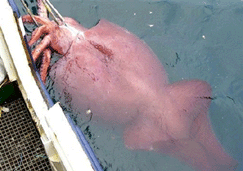
« PREVIOUS ENTRY
Snow hacking

Man, these things just keep getting more and more gigantic: Fishermen off the coast of New Zealand were out catching patagonian toothfish when they snared Mesonychoteuthis hamiltoni — a colossal squid, the 747 of the briny deep. At 990 pounds and 39 feet long, it’s 50% larger than the next biggest specimen ever caught; and since colossal squid are assumed to grow to a maximum of 46 feet, it’s pretty close to being the biggest one you could catch.
Though who knows? The 46-foot estimate is based on studying the occasional colossal-squid corpse accidentally caught in nets or washed up on shores, so maybe these majestic beasts grow larger yet. At which point it makes you wonder, to what increasingly florid adjectives might we one day be forced to resort? What comes after “giant squid” and “colossal squid”, anyway? “Ginormous squid”? “Just-totally-way-huge squid”? My favorite quote from an Associated Press article on the catch:
“I can assure you that this is going to draw phenomenal interest. It is truly amazing,” said Dr. Steve O’Shea, a squid expert at the Auckland University of Technology. If calamari rings were made from the squid they would be the size of tractor tires, he added.
Nice. Mind you, given that the flesh of colossal squid are deeply infused with ammonia — to make them neutrally bouyant, neither rising nor falling in the water — that would be some rather nasty-tasting hors d’ouerves.
(Thanks to Frances, Joseph and Will for this one!)
I'm Clive Thompson, the author of Smarter Than You Think: How Technology is Changing Our Minds for the Better (Penguin Press). You can order the book now at Amazon, Barnes and Noble, Powells, Indiebound, or through your local bookstore! I'm also a contributing writer for the New York Times Magazine and a columnist for Wired magazine. Email is here or ping me via the antiquated form of AOL IM (pomeranian99).

ECHO
Erik Weissengruber
Vespaboy
Terri Senft
Tom Igoe
El Rey Del Art
Morgan Noel
Maura Johnston
Cori Eckert
Heather Gold
Andrew Hearst
Chris Allbritton
Bret Dawson
Michele Tepper
Sharyn November
Gail Jaitin
Barnaby Marshall
Frankly, I'd Rather Not
The Shifted Librarian
Ryan Bigge
Nick Denton
Howard Sherman's Nuggets
Serial Deviant
Ellen McDermott
Jeff Liu
Marc Kelsey
Chris Shieh
Iron Monkey
Diversions
Rob Toole
Donut Rock City
Ross Judson
Idle Words
J-Walk Blog
The Antic Muse
Tribblescape
Little Things
Jeff Heer
Abstract Dynamics
Snark Market
Plastic Bag
Sensory Impact
Incoming Signals
MemeFirst
MemoryCard
Majikthise
Ludonauts
Boing Boing
Slashdot
Atrios
Smart Mobs
Plastic
Ludology.org
The Feature
Gizmodo
game girl
Mindjack
Techdirt Wireless News
Corante Gaming blog
Corante Social Software blog
ECHO
SciTech Daily
Arts and Letters Daily
Textually.org
BlogPulse
Robots.net
Alan Reiter's Wireless Data Weblog
Brad DeLong
Viral Marketing Blog
Gameblogs
Slashdot Games